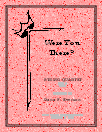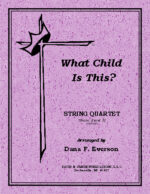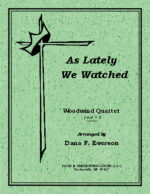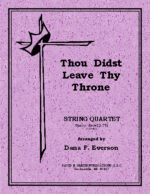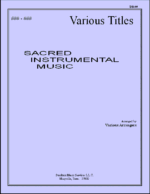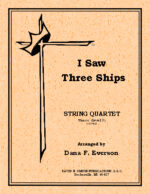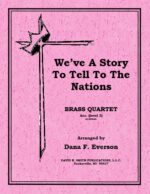-
-
What Child Is This?
$10.50A string quartet with optional third violin for viola. After a brief introduction the theme is presented in a straight forward ensemble harmonization with some altered pitches. The next section places the melody in the viola line with opposing lines in the violins. The ensuing section now gives the tune to the second violin with contrapuntal action in the other voices. A chorus section is now more articulated and active until the tune is handed to the first violin with ever more moving counterpoint in the other voices. The piece then ends in a strong statement.
-
As Lately We Watched
$11.00A woodwind quartet with optional parts is presented in a joyful manner giving a sense of expectation. After a pert introduction, the melody is stated with a solo clarinet with answering figures rotated amongst the other voices. A joyful bridge section gravitates towards a modulation with the tune stated in the lower voices. The piece goes into a free, flourishing motion where it heads into yet another modulation. The tune now is doubled in the flute and clarinet with accompaniment figures moving in hemiola sets. After a set of imitation figures passed about the ensemble the piece goes into a coda section with more joyful figures.
-
Thou Didst Leave Thy Throne
$9.00A string quartet with optional violin for viola. After a full ensemble introduction the piece gives way to a duet in the viola and cello. With the violins entering one at a time the piece now becomes full with all parts present gravitating to motivic development moving to a modulation. The next section gives the tune to the cello with the upper lines adding punctuated accompanied figures. The next section uses motivic patterns while passing portions of the tune to the various players. A modulation- then the parts become increasingly more active in a variation style. With a solid ensemble altering the melody; a brake; then, repose.
-
Is Your All On The Altar?
$9.50A woodwind trio or quartet with piano accompaniment and optional guitar. Woodwind parts are for flute and clarinet with optional part oboe, clarinets and alto sax. After a brief introduction the flutes introduce the tune and then answered by the clarinet. The flute and clarinet answer back and forth until all parts move in block harmony with rhythmic alterations. After a modulation the ensemble continues in block harmonic movement until punctuated by the inner parts. While the color remains consistent to the end, the melody moves about amongst the parts until final resolution.
-
-
-
I Saw Three Ships
$10.50This string quartet is a rollicking rendition of this old carol. The melodic material is passed around amongst all the parts to give color and interest. As well, the punctuations of pizzicato and various other articulations adds a good stimulation for interest as to what is going to haooen next? Colorful! Entergetic! Delightful! This piece has it all!
-
We’ve A Story To Tell To The Nations
$8.00Presented in a stately march style this piece would serve well in any venue that has a missional theme. The piano part acts as a driving force that gives a forward motion with brass parts that give regal accentuations as well as various color combinations for constant interest.
-
Abba, Father
$9.95This song by Ron Hamilton is beautifully arranged in a mild manner where the brass parts are presented in soloist fashions, imitative motives and full chordal movements. The piano serves to give movement and embellishment- all in all, a delightfully meditative piece.
-
In The Garden
$9.95SMS: For string quartet and piano. The opening has the strings using a modified melody in a chordal structure. It continues in much the same light with the piano embellishing with lines of elegance. The second section features the melody in the left hand of the piano (doubled in the cello ) with chordal structure in the right, all the while the upper strings adding a shimmering effect with tremolos. Then the quartet continues with full ensemble sound giving way to an unaccompanied trio of the upper three parts. The piece continue on in much the same flavor as the beginning coming to a sweet conclusion.
-
-
-
No Other Plea
$14.95SMS: Brass quartet for two trumpets and two trombones (opt horn and BHTC). This piece presents the tune in various harmonic ways- unison, duet line and full chord. It is straight forward in its presentation.
-
Chorus Medley
$14.95SMS: Brass quartet for two trumpets and two trombones (opt horn and BHTC) and piano. The texture moves the thematic material between the upper and lower voices- generally in block harmony formats. This selection is a medley incorporating: “I Will Sing Of The Mercies,” “Hallelujah,” and “God Is So Good.” It concludes with a brief statement of “I Will Sing”.
-
At The Cross
$14.95SMS: Brass quartet for two trumpets and two trombones (opt horn and BHTC) and piano. The piece is straight forward with much of the interest in the thematic material alternating between the upper and ,lower instruments. The middle section is in unison, then breaking into a chordal structure. The ending section is spritely, concluding on a solid footing.
-
-
-
Medley of Christmas Songs
$9.95Brass quartet (2 trp, 2 trm, (opt horn and Bar TC): Hark The Herald Angels Sing, Silent Night, Away In A Manger
-
Lead Me To Calvary
$9.95SMS: Brass quartet for two trumpets and two trombones (opt horn and BHTC) The pieces starts out immediately in the nature of the original hymn in four part harmony. The next section is slower and very expressive with harmonic movement in all the parts, followed by the melody in the lower voices and a counter line in the trumpets. The final section is alla marcia growing to a final codetta that is strong in confidence and then relaxes into repose.
-
In The Garden
$9.95SMS: Brass quartet for two trumpets and two trombones (opt horn and BHTC) The open passage presents the melodic motif amongst the parts which sets it up for the first presentation of the melody in the trumpets with a gentle contrapuntal fill of the low brass. This continues throughout the entire section. The second section is rich in counterpoint with strong emotion with movement in all parts. The final section is reminiscent of the first which transition to a gentle coda establishing repose.
-
-
-
-

